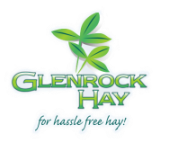|
To make the bale of hay that arrives in your shed ready for your horse, cow, llama or other animal to eat involves a long process that relies heavily on the weather - both for the growing of the crop and for the right conditions to achieve a good quality hay bale. In growing the crop, water needs to be given at the right time as to not cause stress on the plant. This can cause early flowering inLucerne and also encourage the plant to be more leggy or stalky. Once cut, the crop needs to be raked in to wind-rows which are then turned each day until fully dry. This daily raking allows the sun and wind to dry the plant quickly, thereby reducing the nutrient loss and bleaching of the plant. During summer this may take as little as three days while in winter it can take up to three weeks or more. While on the ground the crop is highly susceptible to rain as it doesn’t take a great deal of rain to leach the nutrients from the plant matter and render the hay worthless. Once the plant matter has dried to the correct moisture content (<20%), it is then ready for baling. Baling is usually undertaken in the evening or early morning, once the dew comes down, as a small amount of moisture is necessary to ensure the leaf remains on the plant and doesn’t crack and crumble during the baling process. The hay bales then need to be picked up from the paddock as quickly as possible to prevent fading and drying out from the sun. Once picked up the bales are then stacked in the storage shed, and will need to be checked initially for any overly moist bales that could spontaneously combust.
0 Comments
Like any dry food, hay should be kept in a cool, dry, dark place. The most important of these conditions by far is dry and this should be achieved at the expense of the other two conditions if necessary. Whilst rain is an obvious way that hay can get wet, moisture from the air and condensation are more insidious forms and generally cause the biggest problems. The following are a list of do’s and don’ts with regard to hay storage.
Founder and laminitis are often used interchangeably but are actually two separate but related illnesses that affect horses. Laminitis is the inflammation of the horses foot and founder is the name given to the tissue damage and complications that occur from an attack of laminitis. There are many opinions on the causes of laminitis ranging from grazing on lush pasture or overeating of grain to drinking large volumes of water while the horse is overheated or even a retained placenta in a foaling mare.
The NLIS (or National Livestock Identification Scheme) is being introduced in Australia in an effort to be able to trace animals from birth to slaughter. This will enable producers to find improvements in market access as well as aiding in disease management and issues relating to residue control.
|
Craig KapernickArchives
December 2013
Categories |

 RSS Feed
RSS Feed
